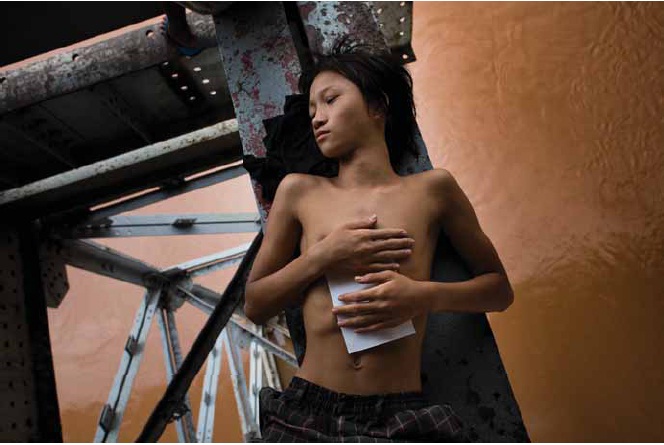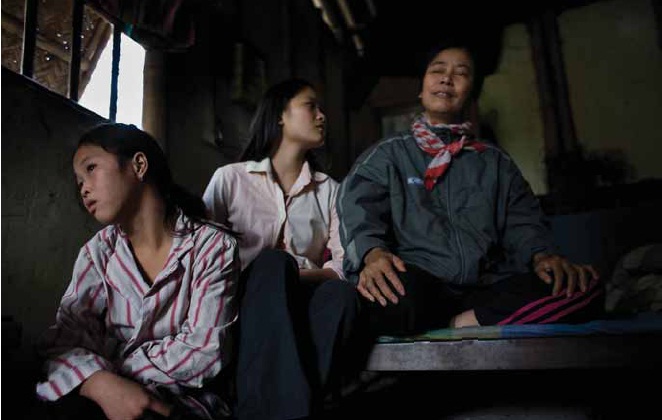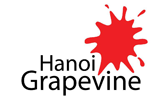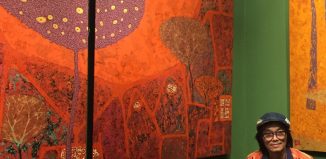Mai Chi – Long Bien in Visual Art
 |  |
A shortened version appeared in the Hanoi Grapevine column on The Word Jul 2011. Click here to see the version in Word Hanoi.
As Hanoi is getting more affluent, it is becoming harder for locals and foreigners alike to finds the “authentic”. The Old Quarter, once representing that special Hanoi feeling, has been morphing itself into a giant touristic carousel where, as you walk on the stone pavement, your smart phone would never run out of free Wi-Fi signals. And the vendor woman with her conical straw hat and bamboo pole which every travel log mentions has by now figured out how to arrange the few fruits in her baskets in a way it looks good when tourists try it out on their shoulder for a buck in exchange.
In light of this loss of the exotic, the middle island of the Red River offers a comfortable alternative, so close and yet so far away. Spanning over 5 km, from the Chuong Duong Bridge in the South up to where the Duong River branches off from the Red River, this stretch of land is wild, untouched and fascinating strange. In a way, this is the Central Park of Ha Noi, drawing diverse groups of population who otherwise would seldom meet. On the one side are the temporary, the ones descending down for a short visit. Young urbanites take their wedding pictures with the Long Bien Bridge as the backdrop. Lovesick teenagers draw giant heart into the sand. Stylish office employees try out horse riding services. Middle-aged male nudist exercise self-invented Yoga moves. This is the playground of the middle class, coming here with camera lens the thick of their leg, seeking for the best photo motive in the thrill of a semi-unstructured environment. On the other side, of course, are the permanents: junkies and prostitutes, nutters and weirdoes, homeless and slum dwellers, the have-nots who seeks the freedom offered by an abandoned space and the protection of a lawless place. On the island they can safely be quasi outside and beside the system, no birth certificates for the new born, but also no police patrol. Here, in solitude, they can give themselves over to their madness, their thirst for cocaine or re-patch their shanty.
No wonder more and more visual artists have been attracted by the island, the old bridge and the surrounding at its both ends. Douglas David Jardine has been making pictures here since 2008. His analog, black and white photos, taken with vintage cameras, have the harsh contrast which reminds of old photos of the 19th and early 20th century. The pictures seem to come from a long, lost world, bare of any sentimentality. Many are devoid of people, and if they do appear, they only occupy a small part of the space, seemingly being lost in the vast land.

The dozen or so of panoramic pictures of the area, collected at the site www.360cities.net, offer an unusual viewing experience. In these so-called spherical panoramas, not only you can rotate 360 degree, but you can also look up and down. Comi Valentine’s night view on the Long Bien Bridge is arresting; the seamlessly stitched, ultra sharp picture brings out all the time loaded upon the iron structure, against the bright light of the city in the distance. His “Long Bien bus station at night” is soaked in urban loneliness which could come out of Wong Kai-Wai’s Hong Kong of the 70’s.
Jamie Maxtone-Graham is another photograph who has been working on Long Bien for some years. Like Jardine, he takes an almost ethnographical approach, but his photos are harder, more brutal. A young guy resting on an narrow iron beam 20m above the water; a fully tattooed, half-crazy man in the mud looking up; a hand checking the glazing eyes of a drug-addicted; a worker standing behind a crossing electric line at the height of his eyes; a close-up of a guy giving him a heroine shot close to his private part; people cramped in their hut, shot from below, doing nothing, as if waiting. In late 2010, Maxtone-Graham curated the Long Bien Picture Show, featuring four filmmakers and four photographs including him. One of them, Boris Zuliani, shot young couples hanging out on the bridge at night, mostly in shorts and shirts, slippers or bare footed, on or next to their bikes. The extremely long exposure forced people to hold still in their pose for one minute while he did the lighting around them. The results are flat photos looking like painting, softly and blurred, and capturing the life spirit of the young in a tropical city, elegant and beautiful because of their youth.
The most pompous work on the subject so far has been the installation “Migrant in the city” by Nguyen Hong Phuong and Vu Lam, on view just last April. If the show proved one thing then it’s the fact that contemporary art in Vietnam is getting more and more spectacular: big trees are stitched together, herds of pigs are skinned and stuffed. In this case, a shelter of a family in the island slum, half boat half hut, was bought, moved, lifted and dropped onto the yard of the Fine Art University, an engineering act which seemed to excite many people in the art scene. Grand in gesture, “Migrant in the city”, however, is voyeurism posing as art. The hundred of photos accompanying the show could well be curious snap shots of any slum tour: this is how the poor wash themselves, this is how they cook, and this is their cat… In the opening night at the University’s campus, it’s awkward to watch 1.9 m tall Westerners bending themselves to get through the hole of the cramped shack to see, yes, to see what? At best, the show sends out plain, worn out social messages (“there is still so much poverty even in Hanoi”), at worst, it’s naïve poverty romanticism (“look, how happy these poor people are”).
There is one thing indicated by “Migrants in the city”: by now the social gaps in Hanoi are so large that the better off have developed a curiosity about how “the Others” live. Slum tourism is nothing new; it has already existed in Victorian London. Who knows, in a few years, if this boat-hut cluster on the middle island grows to a respectable size, there might be a company offering a tour. Given the trend, they may make decent profits. At least then you wouldn’t need a show like the one above to be able to peek into a shanty.
Photos by Jamie Maxtone-Graham.
![]()
| Mai Chi is a Hanoi-based arts commentator and has been contributing to various online media. |
















